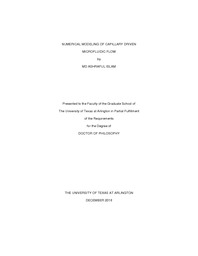
ATTENTION: The works hosted here are being migrated to a new repository that will consolidate resources, improve discoverability, and better show UTA's research impact on the global community. We will update authors as the migration progresses. Please see MavMatrix for more information.
Show simple item record
| dc.contributor.advisor | Tong, Albert Y. | |
| dc.creator | Islam, Md Ashraful | |
| dc.date.accessioned | 2017-02-14T16:38:43Z | |
| dc.date.available | 2017-02-14T16:38:43Z | |
| dc.date.created | 2016-12 | |
| dc.date.issued | 2017-01-05 | |
| dc.date.submitted | December 2016 | |
| dc.identifier.uri | http://hdl.handle.net/10106/26436 | |
| dc.description.abstract | Capillary driven two dimensional axisymmetric and three dimensional asymmetric flow in various microfluidic applications have been modeled and analyzed numerically. The transient Navier-Stokes equations are solved using a finite-difference formulation with a two-step projection method on a fixed grid. The vapor-liquid interface of the micro-droplet is tracked by volume-of-fluid (VOF) and coupled level set and volume-of-fluid (CLSVOF) methods with the surface tension force determined by the continuum surface force (CSF) model. The static contact angle at the three phase contact line has been modeled using wall adhesion scheme within the CSF framework. The developed numerical method for capturing the microfluidic flow with free surface has been validated using well-established benchmark tests.
Dynamics of drop formation from a vertical capillary tube and subsequent generation of satellite drops in air have been studied numerically. The evolution of complete droplet separation process has been simulated. The numerical results have been compared with published experimental data. The various stages of pendant droplet formation have been examined. These include: necking, bifurcation, recoil, wave generation and secondary necking and bifurcation. The mechanism for the recoiling of the liquid filament after droplet detachment and the subsequent formation of a satellite droplet has been investigated. Parametric studies on the effects of inlet velocity, surface tension and viscosity have been performed. Controlling factors conducive for satellite droplet formation have been identified.
Electrowetting induced micro-water droplet detachment from the hydrophobic surface has been studied numerically. The results of the numerical model have been validated with published experimental data and the physics of stretching, recoiling and detachment of the droplet have been examined. A parametric study has also been performed in which the effects of droplet volume, voltage amplitude and voltage pulse width have been studied.
Electrowetting induced micro-water droplet transports in parallel-plate and open-plate Electrowetting-on-Dielectrode (EWOD) have been studied numerically. The results of the numerical model have been validated with published experimental data and the physics of droplet transport have been investigated. Velocity and pressure profiles inside the deformed droplet have been analyzed using electrowetting theory. The change of apparent contact angle within the small channel gap has been captured as the droplet is transported in parallel-plate EWOD devices. A parametric study has been performed in which the effects of voltage amplitude, channel gap and electrode size have been examined. Furthermore, the average transport velocity in open-plate and parallel-pate EWOD has been compared. | |
| dc.format.mimetype | application/pdf | |
| dc.language.iso | en_US | |
| dc.subject | Micro-fluidic flow | |
| dc.subject | EWOD | |
| dc.subject | Satellite drop | |
| dc.subject | Electrowetting | |
| dc.subject | Capillary actuation | |
| dc.title | Numerical Modeling of Capillary Driven Microfluidic Flow | |
| dc.type | Thesis | |
| dc.degree.department | Mechanical and Aerospace Engineering | |
| dc.degree.name | Doctor of Philosophy in Mechanical Engineering | |
| dc.date.updated | 2017-02-14T16:38:43Z | |
| thesis.degree.department | Mechanical and Aerospace Engineering | |
| thesis.degree.grantor | The University of Texas at Arlington | |
| thesis.degree.level | Doctoral | |
| thesis.degree.name | Doctor of Philosophy in Mechanical Engineering | |
| dc.type.material | text | |
Files in this item
- Name:
- ISLAM-DISSERTATION-2016.pdf
- Size:
- 5.343Mb
- Format:
- PDF
This item appears in the following Collection(s)
Show simple item record


